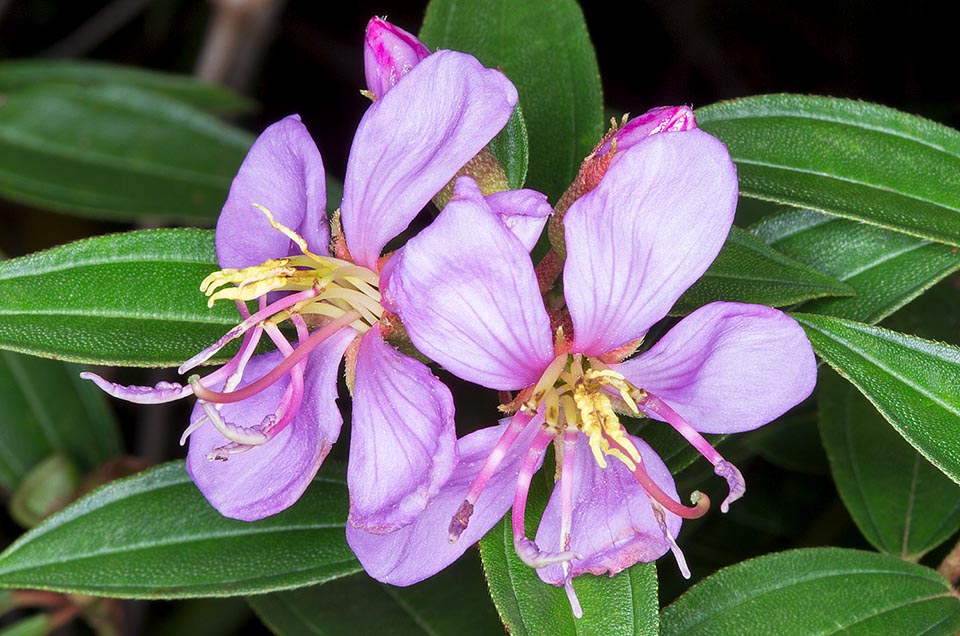Family : Melastomataceae

Text © Pietro Puccio

English translation by Mario Beltramini
The species is native to Australia (Northern Territory, Queensland and Western Australia), Bhutan, Cambodia, China (Guangdong, Guangxi, Guizhou, Hainan, Hunan, Jiangxi, Sichuan, Xizang, Yunnan and Zhejiang), India, Indonesia, Japan, Laos, Mauritius, Nepal, New Guinea, Peninsular Malaysia, Seychelles, Singapore, Taiwan, Thailand and Vietnam, where it grows in the sparse forests, in the prairies, in the uncultivated lands and at the margins of roads and paths from the sea level upto about 2500 m of altitude.
The name of the genus is the combination of the Greek adjective “μέλας” (melas) = black and of the substantive“στόμα” (stoma) = mouth, with reference to the fruits of some species that when eaten colour the mouth and the lips of black; the specific name is the Latin adjective “malabathricus, a, um” = of Malabar, region of south-western coast of India, with reference to one of its origin places.
Common names: banks melastoma, Indian rhododendron, Malabar melastome, Singapore rhododendron (English); ye mu dan (Chinese); malatungai (Philippines); mélastome du Malabar (French); karali, nekkarike, palore, rongmei, shapti, yachubi (India); harendong, kemanden (Indonesia); kenduduk, senduduk (Malaysia); bre, chuk naaree, mang kre (Thailand); mua da hung, mua se (Vietnam).
The Melastoma malabathricum L. (1753) is an erect perennial shrub, evergreen, ramified, very variable, usually 0,5-2 m tall, but that in some specimens in nature can reach the 5 m, with the young branches almost quadrangular, cylicrical the old ones, of reddish colour and rough due to the presence of tiny scales.

The 5-7 cm flowers of Melastoma malabathricum can be white, violaceous or purple. They have 5 long stamina with violaceous anthers and 5 short with yellow anthers © Giuseppe Mazza
Terminal cymose inflorescences bearing 3-11 flowers, on a 2-10 mm long pedicel, of 5-7 cm of diameter, bisexual with urceolate hypanthium, 5-10 mm long, green to reddish, thickly covered by 0,5-2 mm long scales, 5 sepals from triangular to lanceolate with pointed apex, 4-6 mm long, pubescent, deciduous, interspersed with small teeth, 5 obovate petals, 1,5-3,5 cm long and 1-2 cm broad, white to violet, to reddish purple, 10 stamina, of which 5 long, 2,2-3 cm curved with violet anthers, 5 shorter, 1,8-2,2 cm, with yellow anthers.
The fruits are fleshy capsules, globose-urceolate, 0-7-1,3 cm long and 0,6-1 cm of diameter, strigose, of green colour with shades from pink to pale brown, irregularly dehiscent, containing a multitude of tiny orange seeds, about 0,5 mm long, immersed in a blackish purple pulp, edible, but rather vapid.
It easily reproduces by seed in sandy loam maintained humid at 24-28 °C of temperature, with germination times from 2 to 4 weeks, and by apical cutting.

The 50-200 cm tall shrub may reach the 5 m of height in South-East Asia. Ornamental species but invasive. Edible fruits and medicinal virtues © Giuseppe Mazza
In some origin places parts of the plant are utilized in the popular medicine, in particular leaves and roots are utilized as remedy to diarrhea and dysentery; laboratory studies have evidenced in various parts of the plant the presence of bioactive compounds with antibacterial, antioxidants, antiinflammatory and antidiarrheal properties, of possible interest for the official pharmacopoeia.
Synonyms: Melastoma affine D. Don (1823); Melastoma candidum D. Don (1823); Melastoma normale D. Don (1825); Melastoma polyanthum Blume (1831); Melastoma cavaleriei H. Lév. & Vaniot (1906); Melastoma esquirolii H. Lév. (1910); Melastoma malabathricum var. normale (D. Don) R.C. Srivast. (1998); Melastoma malabathricum subsp. normale (D. Don) Karst. Mey. (2001).
→ To appreciate the biodiversity within MELASTOMATACEAE family please click here.
